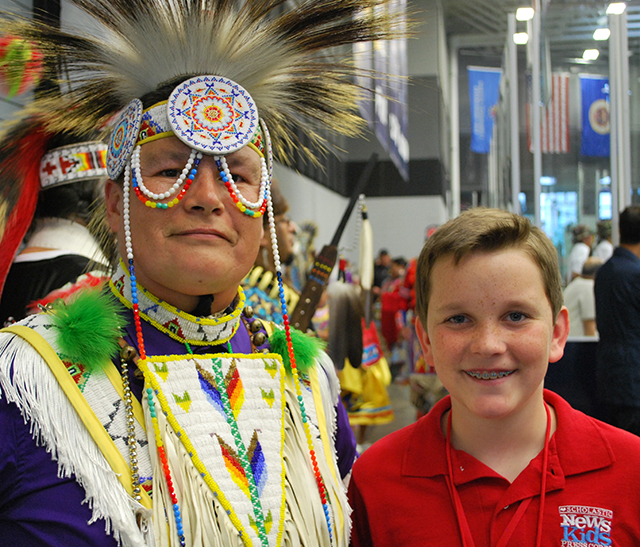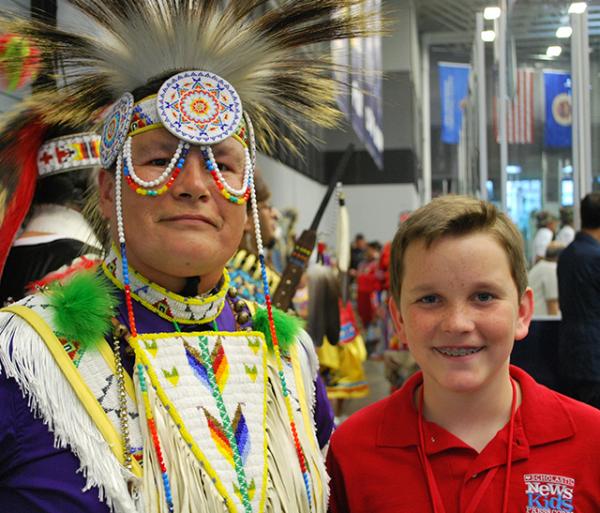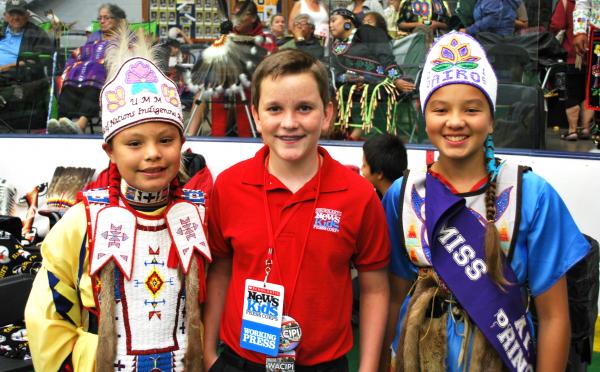KID REPORTERS’ NOTEBOOK
Celebrating Ancient Roots


Ryan with an elder at a wacipi in Shakopee, Minnesota
American Indians often gather to celebrate their culture, heritage, dance, and song at special events called “wacipis” (WAH-sheep-eez). In the Dakota language, “wacipi” means, “They all dance.” These festivities are commonly referred to as pow wows.
I recently attended a wacipi in Shakopee, Minnesota. More than 700 Native Americans from the United States and Canada came together to celebrate their friendship and common heritage. The event was hosted by the Shakopee Mdewakanton Sioux Community.
Dancers of all ages wore colorful regalia from head to toe. The intricately-designed clothing often represents the wearer’s tribe, family, martial status, and personal history.
THE STORIES BEHIND CEREMONIAL CLOTHING
My favorite question to ask participants at the wacipi was which item of their ceremonial clothing held the most meaning to them. Many Native Americans wear traditional clothing that was passed on to them from their ancestors, while others wear items that reflect their own personal journey.
Allen Johnson, 8, of the Shakopee Mdewakanton Sioux Community, said that his roach headdress was the most meaningful part of his regalia. “My mom made me earn it, and it’s a really important thing to me,” Allen said.
Rosemma Lafferty, 18, of the Shakopee Mdewakanton Sioux Community said, “The most meaningful is probably my moccasins because it’s what we dance in.”
 Ryan at the wacapi with young attendees
Ryan at the wacapi with young attendees
Timothy Eashappie from the Carry the Kettle Nakoda Tribe in Saskatchewan, Canada, pointed to his necklace and said, “These are all elk teeth. They’re not fake. They’re not imitations. These are the real teeth of elks that I took when I was hunting.”
CONNECTING TO THE PAST
Veronica Briggs of the White Earth Mississippi Band of Ojibwe said that attending wacipis with her family is a frequent occurrence. “Every year I go to at least ten,” Briggs said, adding that wacipis are the way that songs and dances are passed from one generation to another.
“This is an important experience for the young kids, even the little tiny tots,” Briggs said. “We come here and we learn the little things piece by piece.”
Anika Pendelton-Burnett of the Lower Sioux Indian Community agreed. “I feel one with my ancestors and my people,” she said. “Events like these have been happening since way back, and they have been doing these same dances and wearing the same regalia, and it just connects us. It’s kind of unexplainable.”
See Ryan's interviews at a wacipi.
